Engineers play a pivotal role in optimizing mixer gearbox performance to meet the demands of industrial mixing applications. Central to this optimization process is the careful adjustment of gear ratios within the mixer gearbox to achieve the desired mixing speeds and torque. By fine-tuning these ratios, engineers ensure efficient operation while meeting specific processing requirements.
Gear ratios in a mixer gearbox are tailored to balance the rotational speed of the mixer shaft with the torque needed to effectively blend ingredients. This optimization process involves a thorough analysis of the mixing task at hand, considering factors such as viscosity, batch size, and desired mixing intensity. Through mathematical modeling and simulation, engineers determine the ideal gear ratios to achieve good performance without compromising energy efficiency or equipment longevity.
Safety considerations are paramount in the operation and maintenance of mixer gearboxes. These powerful components pose risks if not handled properly. Operators must be trained in safe operating procedures, including proper startup and shutdown protocols, as well as emergency response measures. Regular maintenance checks are essential to detect potential issues before they escalate into safety hazards. Guarding mechanisms and lockout/tagout procedures are implemented to prevent accidental contact with moving parts.
Temperature fluctuations can significantly impact the performance and lifespan of mixer gearboxes. Extreme temperatures can affect lubrication viscosity, leading to inadequate lubrication and increased friction within the gearbox. This friction generates heat, further exacerbating temperature fluctuations and potentially causing premature wear on components. To mitigate these effects, engineers select lubricants with appropriate viscosity ranges for the operating conditions and implement cooling systems to regulate temperature within the gearbox enclosure.
In conclusion, optimizing mixer gearbox performance involves a meticulous balance of gear ratios to achieve desired mixing outcomes, rigorous adherence to safety protocols to protect operators and equipment, and proactive measures to mitigate the effects of temperature fluctuations on gearbox performance and longevity. By addressing these factors comprehensively, engineers ensure the reliable and efficient operation of mixer gearboxes in industrial mixing applications.



